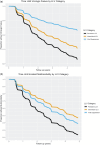Consequences of low-level viremia among women with HIV in the United States
- PMID: 39110550
- PMCID: PMC11424065
- DOI: 10.1097/QAD.0000000000003990
Consequences of low-level viremia among women with HIV in the United States
Abstract
Objective: Investigate the outcomes of women with HIV (WWH) with low-level viremia (LLV).
Design: The prevalence of LLV and potential clinical sequelae, such as virologic failure and non-AIDS comorbidity (NACM) development, are poorly characterized among WWH.
Methods: We analyzed data from the Women's Interagency HIV Study among WWH enrolled from 2003 to 2020 who reported antiretroviral therapy use at least 1 year followed by an HIV-1 viral load less than 200 copies/ml. Consecutive viral load measurements from four semi-annual visits were used to categorize women at baseline as having: virologic suppression (all viral load undetectable), intermittent LLV (iLLV; nonconsecutive detectable viral load up to 199 copies/ml), persistent LLV (pLLV; at least two consecutive detectable viral load up to 199 copies/ml), or virologic failure (any viral load ≥200 copies/ml). Adjusted hazard ratios quantified the association of virologic category with time to incident virologic failure and multimorbidity (≥2 of 5 NACM) over 5-year follow-up.
Results: Of 1598 WWH, baseline median age was 47 years, 64% were Black, 21% Hispanic, and median CD4 + cell count was 621 cells/μl. After excluding 275 women (17%) who had virologic failure at baseline, 58, 19, and 6% were categorized as having virologic suppression, iLLV, and pLLV, respectively. Compared with WWH with virologic suppression, the adjusted hazard ratio [aHR; 95% confidence interval (CI)] for incident virologic failure was 1.88 (1.44-2.46) and 2.51 (1.66-3.79) for iLLV and pLLV, respectively; and the aHR for incident multimorbidity was 0.81 (0.54-1.21) and 1.54 (0.88-2.71) for iLLV and pLLV, respectively.
Conclusion: Women with iLLV and pLLV had an increased risk of virologic failure. Women with pLLV had a trend towards increased multimorbidity risk.
Copyright © 2024 The Author(s). Published by Wolters Kluwer Health, Inc.
Conflict of interest statement
There are no conflicts of interest.
Figures
References
-
- Guidelines for the use of antiretroviral agents in adults and adolescents living with HIV. Available at: https://clinicalinfo.hiv.gov/en/guidelines/hiv-clinical-guidelines-adult.... [Accessed 5 January 2023]
-
- Vandenhende MA, Ingle S, May M, Chene G, Zangerle R, et al. . Antiretroviral Therapy Cohort Collaboration (ART-CC). Impact of low-level viremia on clinical and virological outcomes in treated HIV-1-infected patients. AIDS Lond Engl 2015; 29:373–383. - PubMed
MeSH terms
Grants and funding
- T32 AI157855/AI/NIAID NIH HHS/United States
- U54 AG062334/AG/NIA NIH HHS/United States
- U01 HL146205/HL/NHLBI NIH HHS/United States
- U01 HL146208/HL/NHLBI NIH HHS/United States
- U01 HL146192/HL/NHLBI NIH HHS/United States
- TL1 TR001431/TR/NCATS NIH HHS/United States
- U01 HL146193/HL/NHLBI NIH HHS/United States
- UL1 TR002378/TR/NCATS NIH HHS/United States
- U01 HL146194/HL/NHLBI NIH HHS/United States
- U01 HL146241/HL/NHLBI NIH HHS/United States
- P30 AI027767/AI/NIAID NIH HHS/United States
- P30 AI050409/AI/NIAID NIH HHS/United States
- U01 HL146333/HL/NHLBI NIH HHS/United States
- KL2 TR002381/TR/NCATS NIH HHS/United States
- U01 HL146245/HL/NHLBI NIH HHS/United States
- K23 AG084415/AG/NIA NIH HHS/United States
- U01 HL146242/HL/NHLBI NIH HHS/United States
- P30 AI073961/AI/NIAID NIH HHS/United States
- U01 HL146201/HL/NHLBI NIH HHS/United States
- U01 HL146204/HL/NHLBI NIH HHS/United States
- U01 HL146202/HL/NHLBI NIH HHS/United States
- UL1 TR001881/TR/NCATS NIH HHS/United States
- UL1 TR000004/TR/NCATS NIH HHS/United States
- U01 HL146203/HL/NHLBI NIH HHS/United States
- UL1 TR003098/TR/NCATS NIH HHS/United States
- P30 AI050410/AI/NIAID NIH HHS/United States
LinkOut - more resources
Full Text Sources
Medical
Research Materials




